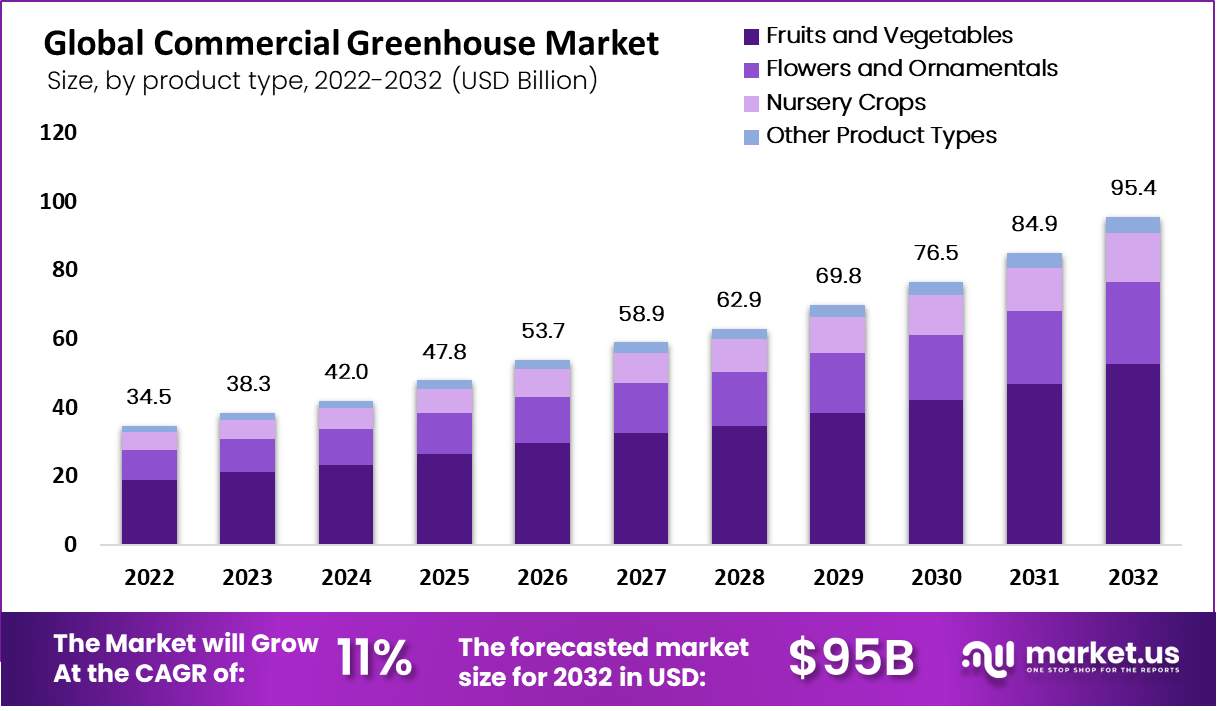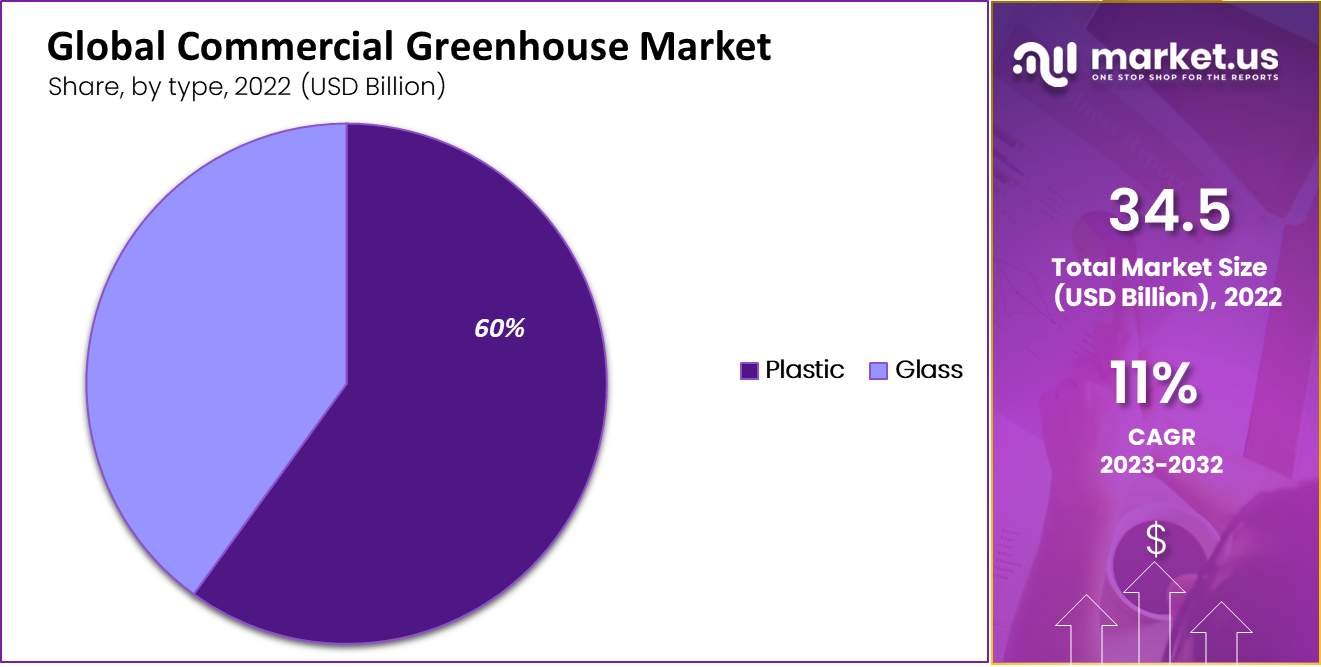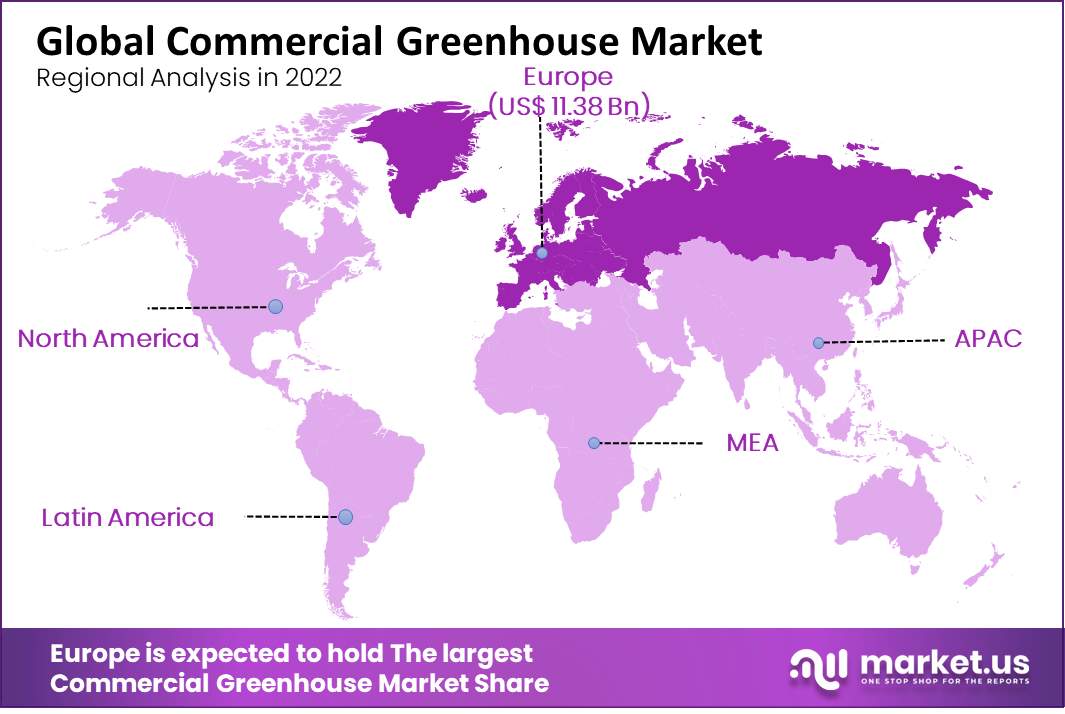Global Commercial Greenhouse Market By Type (Glass and Plastic), By Product Type (Fruits and Vegetables, Flowers and Ornamentals, and Other Product Types), By Equipment, By Region and Companies - Industry Segment Outlook, Market Assessment, Competition Scenario, Trends, and Forecast 2023-2032
- Published date: Oct 2022
- Report ID: 103510
- Number of Pages: 346
- Format:
- keyboard_arrow_up
Quick Navigation
Report Overview
In 2022, the global commercial greenhouse market was valued at USD 34.5 billion. This market is estimated to reach USD 95.4 billion in 2032 at a CAGR of 11% between 2023 and 2032.
Commercial greenhouses provide a controlled environment for cultivating crops in protected settings. The structure is engineered to provide ideal growing conditions, including temperature, humidity, light levels, and carbon dioxide concentrations.
Commercial greenhouses offer several advantages, such as the year-round growing of crops regardless of weather conditions and a more consistent supply of fresh produce. Furthermore, their precise control of growing conditions leads to healthier plants and higher yields.
Commercial greenhouse operators can cultivate a wide array of crops, such as fruits, vegetables, flowers, and herbs. Common varieties grown in commercial greenhouses include tomatoes, peppers, cucumbers, lettuce, and strawberries.

Key Takeaways
Market Growth and Size: The global commercial greenhouse market was valued at USD 34.5 billion in 2022, and it is projected to reach USD 95.4 billion by 2032, exhibiting a Compound Annual Growth Rate (CAGR) of 11% between 2023 and 2032.
Commercial Greenhouse Overview: Commercial greenhouses provide a controlled environment for crop cultivation, ensuring ideal conditions for growth, including temperature, humidity, light, and carbon dioxide levels. They offer year-round crop production and improved crop quality.
Driving Factors: Demand for Fresh Produce The market is driven by the growing demand for fresh produce like fruits, vegetables, and flowers, which can be grown year-round in commercial greenhouses, protecting crops from pests and extreme weather. Sustainable Farming The need for sustainable farming practices, which conserve resources and reduce environmental impact, is propelling the commercial greenhouse sector.
Restraining Factors: High Initial Investment Commercial greenhouse construction requires substantial investments in land, infrastructure, and machinery, which can be a barrier for small and medium-sized companies. Energy Costs The high energy consumption for lighting, heating, and cooling can be a significant cost for resource-limited businesses. Regulations and Compliance Compliance with regulations related to worker rights, environmental protection, and food safety can be time-consuming and costly for smaller companies.
Segment Analysis: Plastic Greenhouses The plastic segment dominates the market, with a 60% revenue share in 2022, and is expected to continue leading. Glass Greenhouses are growing in popularity, with horticulture glass showing the highest CAGR due to durability and aesthetic value.
Product Type Analysis: Fruits and Vegetables This segment holds a market share of 55% in 2022 and is expected to continue dominating the market, driven by the protection of crops from external elements.
Equipment Analysis: Heating Systems Heating systems are crucial in commercial greenhouse production, with a 52% revenue share. Efficient temperature control promotes plant growth.
Growth Opportunities: Technological Advancements Automation, AI, and other technologies are improving crop cultivation, increasing yields, and reducing costs. Urban Farming Urban farming is on the rise, and commercial greenhouses are meeting the demand for locally-grown produce.
Latest Trends: Technology Adoption: Greenhouse operators are increasingly using IoT, automation, and AI to monitor and control crop conditions. Vertical Farming Vertical farming is gaining popularity for maximizing space and crop yields in urban settings. Sustainable Farming Operators are adopting sustainable farming methods to meet consumer demand for eco-friendly options.
Regional Analysis: Europe Europe is the most lucrative market, with a 33% market share, driven by advanced greenhouse techniques and high demand for fruits and vegetables. North America North America is a significant market, while Asia-Pacific is expected to experience the fastest growth.
Key Players: The commercial greenhouse market is highly competitive, with companies like Richel Group, Rough Brothers Inc., and International Greenhouse Company leading the way.
Driving Factors
The Demand for Fresh Produces Drives the Market Growth of Commercial Greenhouses.
The demand for fresh produce, such as fruits, vegetables, and flowers, is driving growth in commercial greenhouses. Their climate allows year-round production while protecting from pests and climate issues.
The commercial greenhouse market is driven by the need for sustainable farming practices that conserve resources and minimize environmental harm. Greenhouse farming is an efficient use of resources such as water, power, and other materials.
Government support in the form of subsidies and incentives is propelling growth in the commercial greenhouse sector. To increase food security and reduce reliance on imported food, governments are encouraging greenhouse farming as a viable option. Modern greenhouse technology, such as automation, sensors, and other digital tools, has enabled commercial greenhouse businesses to flourish.
These improvements boost production, cut costs, and boost yield. As more organic farming practices are employed in commercial settings, there is an increasing need for commercial greenhouses that allow these organic farming techniques without synthetic pesticides or fertilizers to take place.
Restraining Factors
Commercial Greenhouse Construction requires greenfield investments which restrains high costs.
Commercial greenhouse construction necessitates a substantial initial investment in land, infrastructure, and machinery. Small and medium-sized companies that lack the funds to purchase a greenhouse may find this an impediment. Particularly in urban and suburban regions where there is a high demand for locally grown goods, there is often a lack of adequate acreage suitable for greenhouse farming.
Commercial greenhouse operations require high energy usage for lighting, heating, and cooling purposes. Energy costs can be high for companies with limited resources, making energy efficiency a must. Technical expertise in fields like horticulture, plant biology, and engineering is necessary to run commercial greenhouses efficiently and effectively. The commercial greenhouse market’s expansion and development may be hindered by a shortage of qualified workers.
The commercial greenhouse industry is regulated by numerous laws and standards that address worker rights, environmental protection, and food safety concerns. Small and medium-sized companies may find compliance with these requirements to be both time- and cost-intensive.
Traditional agricultural techniques like outdoor farming remain in demand as a more cost-effective alternative than industrial greenhouse farming, creating competition among those operating in this sector of the commercial greenhouse industry.
By Type Analysis
The Plastic Segment holds the Majority of the Market Share During Forecasted Period.
Based on type, the market for the commercial greenhouse is segmented into glass and plastic. Among these types, the plastic segment gets divided into polyethylene, polycarbonate, and polymethyl-methacrylate and is the most lucrative in the global commercial greenhouse market.
The total revenue share of the plastic-type commercial greenhouse is 60% in 2022 and is expected to dominate the market during the forecast period.

The glass greenhouse segment, further divided into horticulture glass and others, is expected to experience the highest CAGR during the forecast period. Glass greenhouses are considered one of the strongest materials due to their weight, durability, strength, and long service life; furthermore, they’re highly valued for their aesthetic value due to their clarity which can be maintained over years with regular cleaning.
By Product Type Analysis
Fruits and Vegetables are the Most Lucrative Products in the Commercial Greenhouse Market.
By product type, the market is further divided into fruits and vegetables, flowers and ornamentals, nursery crops, and other product types. The fruits and vegetables segment is estimated to be the most lucrative segment in the global commercial greenhouse market, with a market share of 55% in 2022, and is anticipated to dominate the target market during the projection period.
The growing greenhouse cultivation of common fruits and vegetables is fueling the segment’s growth. Indoors, they’re protected from elements like wind, cold, drought, bugs, scorching heat, as well as animals trying to consume them.
By Equipment Analysis
The Heating Systems hold the Majority of the Market Share during the Forecasted Period.
Based on equipment, the market is segmented into heating systems, cooling systems, and other equipment. Among this equipment, the heating systems segment is estimated to be the most lucrative segment in the global commercial greenhouse market, with the largest revenue share of 52% during the forecast period.
Heating systems are essential elements in commercial greenhouse production. Systems that maintain consistent temperature control and don’t discharge any hazardous material help foster plant growth and development. A heating system can be centrally or distributed, usually using radiant hot water heating for internal warmth during cold weather conditions. Mixing valves are used to regulate pipe temperatures through flow control mechanisms.
Key Market Segments
Based on Type
- Glass
- Plastic
Based on Product Type
- Fruits and Vegetables
- Flowers and Ornamentals
- Nursery Crops
- Other Product Types
Based on Equipment
- Heating Systems
- Cooling Systems
- Other Equipment
Growth Opportunity
Technological advancements such as Automation, and AI made an Opportunity for effective Cultivation.
Automation, artificial intelligence (AI), and other cutting-edge technology have made it possible for greenhouse operators to monitor and control the growth environment of crops more effectively, leading to larger yields and lower costs. There is also a chance for the creation of novel technologies that could increase the efficiency and sustainability of greenhouse operations.
There is a rising demand for locally grown produce as people become more aware of how food production and transportation affect the environment. Commercial greenhouses can assist in addressing this demand by offering year-round access to fresh produce grown nearby. As more individuals explore ways to raise their own food in cities, urban farming is becoming more popular.
Commercial greenhouses can aid in meeting this demand by giving urban farmers a controlled environment to produce their crops. To increase food security and lessen reliance on imports, governments all around the world are offering incentives for the growth of greenhouse agriculture. This assistance comprises grants for research and development and payments to greenhouse owners.
Latest Trends
Greenhouse operators are increasingly utilizing advanced technologies such as IoT, automation, and artificial intelligence (AI) to monitor and regulate crop conditions more effectively. This trend is expected to continue as technology improves and becomes more widely accessible. Vertical farming, which involves growing crops vertically stacked layers, has seen a recent surge in popularity due to the need to maximize space and boost crop yields in urban settings.
Consumers are becoming more conscious of the environmental effects of food production and seeking sustainable and organic options. To meet this demand, commercial greenhouse operators are now adopting sustainable farming methods.
Regional Analysis
Europe Dominated the Commercial Greenhouse Market.
Europe is estimated to be the most lucrative market in the global commercial greenhouse market, with the largest market share of 33%, and is expected to register a CAGR of 11.5% during the forecast period. Europe and North America hold substantial market shares, but Asia-Pacific is expected to experience the fastest growth over the forecast period.
Europe was an early adopter of advanced greenhouse techniques, particularly in countries like Italy, Spain, and The Netherlands where large areas are under cultivation.
Europe remains the dominant player due to urbanization, rapid technological advances, and high demand for fruits and vegetables in these countries; additionally, population growth coupled with shrinking land in countries such as China or India is anticipated to drive commercial greenhouse market size over this forecast period in the Asia-Pacific region.

Key Regions and Countries
- North America
- The US
- Canada
- Mexico
- Western Europe
- Germany
- France
- The UK
- Spain
- Italy
- Portugal
- Ireland
- Austria
- Switzerland
- Benelux
- Nordic
- Rest of Western Europe
- Eastern Europe
- Russia
- Poland
- The Czech Republic
- Greece
- Rest of Eastern Europe
- APAC
- China
- Japan
- South Korea
- India
- Australia & New Zealand
- Indonesia
- Malaysia
- Philippines
- Singapore
- Thailand
- Vietnam
- Rest of APAC
- Latin America
- Brazil
- Colombia
- Chile
- Argentina
- Costa Rica
- Rest of Latin America
- Middle East & Africa
- Algeria
- Egypt
- Israel
- Kuwait
- Nigeria
- Saudi Arabia
- South Africa
- Turkey
- United Arab Emirates
- Rest of MEA
Key Players Analysis
The global commercial greenhouse market is highly fragmented, featuring a multitude of large, small, and mid-sized manufacturers. To remain competitive in this environment, investments in research & development (R&D) as well as creating novel product portfolios are expected to be key strategies over the forecast period.
Richel Group, Rough Brothers Inc., and International Greenhouse Company are the top three players in this market. The commercial greenhouse business is highly competitive with numerous firms offering growers innovative solutions. According to projections, consumer preference for fresh produce and sustainable agricultural methods will continue driving market growth over the upcoming years.
Market Key Players
- Sotrafa
- Berry Global
- NETAFIM
- Certhon
- Richel Group SA
- Stuppy Greenhouse
- Logiqs B.V.
- Argus Control Systems Ltd.
- Poly-Tex, Inc.
- The Glasshouse Company
- Luiten Greenhouses BV
- Agra Tech, Inc.
- Other Key Players
Recent Developments
- In December 2019, Richel Group and GreenFood successfully finished the construction of a greenhouse for strawberry cultivation in Armenia. Covering an area of 9 hectares, this production facility made GreenFood the largest greenhouse strawberry producer within CIS countries.
- In 2019, Argus Controls and Urban-Gro reaffirmed their strategic partnership to offer automated, plant-centric environmental control solutions in greenhouses to cannabis cultivars across North America.
Report Scope
Report Features Description Market Value (2022) USD 34.5 Bn Forecast Revenue (2032) USD 95 Bn CAGR (2023-2032) 11% Base Year for Estimation 2022 Historic Period 2016-2022 Forecast Period 2023-2032 Report Coverage Revenue Forecast, Market Dynamics, COVID-19 Impact, Competitive Landscape, Recent Developments Segments Covered By Type (Glass and Plastic), By Product Type (Fruits and Vegetables, Flowers and Ornamentals, Nursery Crops, and Other Product Types), By Equipment (Heating Systems, Cooling Systems, and Other Equipment) Regional Analysis North America – The US, Canada, & Mexico; Western Europe – Germany, France, The UK, Spain, Italy, Portugal, Ireland, Austria, Switzerland, Benelux, Nordic, & Rest of Western Europe; Eastern Europe – Russia, Poland, The Czech Republic, Greece, & Rest of Eastern Europe; APAC – China, Japan, South Korea, India, Australia & New Zealand, Indonesia, Malaysia, Philippines, Singapore, Thailand, Vietnam, & Rest of APAC; Latin America – Brazil, Colombia, Chile, Argentina, Costa Rica, & Rest of Latin America; Middle East & Africa – Algeria, Egypt, Israel, Kuwait, Nigeria, Saudi Arabia, South Africa, Turkey, United Arab Emirates, & Rest of MEA Competitive Landscape Sotrafa, Berry Global, NETAFIM, Certhon, Richel Group SA, Stuppy Greenhouse, Logiqs B.V., Argus Control Systems Ltd., Poly-Tex, Inc., The Glasshouse Company, Luiten Greenhouses BV, Agra Tech, Inc., Other Key Players Customization Scope Customization for segments, region/country-level will be provided. Moreover, additional customization can be done based on the requirements. Purchase Options We have three licenses to opt for: Single User License, Multi-User License (Up to 5 Users), Corporate Use License (Unlimited User and Printable PDF) Frequently Asked Questions (FAQ)
What is the value of the global Commercial Greenhouse Market?In 2022, the global Commercial Greenhouse Market was valued at USD 34.5 billion.
What will be the market size for Commercial Greenhouse Market in 2032?In 2032, the Commercial Greenhouse Market will reach USD 95.4 billion.
What CAGR is projected for the Commercial Greenhouse Market?The Commercial Greenhouse Market is expected to grow at 11% CAGR (2023-2032).
List the segments encompassed in this report on the Commercial Greenhouse Market?Market.US has segmented the Commercial Greenhouse Market Market by geographic (North America, Europe, APAC, South America, and MEA). By Type, market has been segmented into Glass and Plastic. By Product Type, the market has been further divided into Fruits and Vegetables, Flowers and Ornamentals, Nursery Crops and Other Product Types.
Which segment dominate the Commercial Greenhouse industry?With respect to the Commercial Greenhouse industry, vendors can expect to leverage greater prospective business opportunities through the Plastic segment, as this dominate this industry.
Name the major industry players in the Commercial Greenhouse Market.Sotrafa, Berry Global, NETAFIM, Certhon, Richel Group SA, Stuppy Greenhouse and Other Key Players are the main vendors in this market.
 Commercial Greenhouse MarketPublished date: Oct 2022add_shopping_cartBuy Now get_appDownload Sample
Commercial Greenhouse MarketPublished date: Oct 2022add_shopping_cartBuy Now get_appDownload Sample - Sotrafa
- Berry Global
- NETAFIM
- Certhon
- Richel Group SA
- Stuppy Greenhouse
- Logiqs B.V.
- Argus Control Systems Ltd.
- Poly-Tex, Inc.
- The Glasshouse Company
- Luiten Greenhouses BV
- Agra Tech, Inc.
- Other Key Players
- settingsSettings
Our Clients
| Single User $4,599 $3,499 USD / per unit save 24% | Multi User $5,999 $4,299 USD / per unit save 28% | Corporate User $7,299 $4,999 USD / per unit save 32% | |
|---|---|---|---|
| e-Access | |||
| Report Library Access | |||
| Data Set (Excel) | |||
| Company Profile Library Access | |||
| Interactive Dashboard | |||
| Free Custumization | No | up to 10 hrs work | up to 30 hrs work |
| Accessibility | 1 User | 2-5 User | Unlimited |
| Analyst Support | up to 20 hrs | up to 40 hrs | up to 50 hrs |
| Benefit | Up to 20% off on next purchase | Up to 25% off on next purchase | Up to 30% off on next purchase |
| Buy Now ($ 3,499) | Buy Now ($ 4,299) | Buy Now ($ 4,999) |












